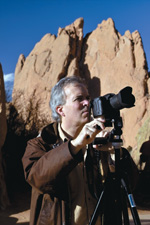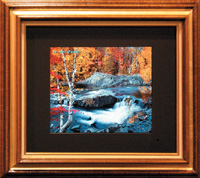|
 Dancing
with Light Dancing
with Light
 David Hughes III '78 first danced
with light on the floorboards of CC's Cossitt Hall.
"I still love the northern light in Cossitt," he
says. "In the spring it bends over the mountains
from the south and comes through the skylights;
in the fall it punches through the windows. I loved
dancing in it!"
David Hughes III '78 first danced
with light on the floorboards of CC's Cossitt Hall.
"I still love the northern light in Cossitt," he
says. "In the spring it bends over the mountains
from the south and comes through the skylights;
in the fall it punches through the windows. I loved
dancing in it!"
Now Hughes dances with light
through a camera lens and choreographs those images
with a tool he helped develop - the Digi-FrameŽ,
a wall-mounted system that sequences thousands of
art-quality scans of fine art and photographs, securely,
from many sources.
Hughes' early interest in photography was superseded
by football, lacrosse, and handball. "I tore up
a knee playing sports," he says. "A girlfriend at
CC told me to take dance to strengthen it. I said,
'You have to be kidding!' Then I sorta liked this
new thing called modern dance, but I thought ballet
was more masculine. And so many girls - I loved
girls!"
Likely the only person ever recruited by both CC
summer dance teacher Hanya Holm and the West Point
football coach, Hughes cut firewood for CC tuition
money so he could "spend gobs of hours as a Cossitt
Hall gym rat" while he worked on an English major.
The New York production of "Brigadoon" highlighted
an eight-year career with touring dance companies;
a barroom bon voyage laid open his heart to Colorado
Springs singer Diana Sanchez just before she grew
ill and needed a liver transplant - an expensive
venture indeed.
 "I had to become immersed in making serious money,
so I got into Internet security," says Hughes. He
moved to Dallas with a tech start-up; five days
later, his new home burned. "Moving is the one time
you have all your possessions together, so I lost
it all - 13 cameras and 25 years of photographs."
"I had to become immersed in making serious money,
so I got into Internet security," says Hughes. He
moved to Dallas with a tech start-up; five days
later, his new home burned. "Moving is the one time
you have all your possessions together, so I lost
it all - 13 cameras and 25 years of photographs."
Hughes bought his first digital camera and was "massively
underwhelmed," he says, by the poor results. So
he bought another, and another. "I finally found
a Sigma that takes art-quality photographs. But
how do we take it into the future? Are we going
to put digital prints and CDs into shoeboxes under
the bed?
"Fifty million digital cameras were sold last year.
We cannot print all the digital photos we take,
and they look blocky anyway! There has to be a direct
expression of this art, and it should satisfy much
finer tastes, like Matisse, Turner, Ansel Adams,
Goya."
It's not just scan quality that matters when digitizing
and displaying fine art, Hughes explains. "Painters
paint pictures in a 4x5 aspect ratio, like a window,
and they plan for art to be viewed at eye level.
A plasma screen has a 5x9 ratio, but the Digi-FrameŽ
is at 4x5. It's not TV, not print, not a slide show
- and I hate the term 'technology.' It's about the
image - this is a canvas for fine art.
"Museums have a big problem. Travel habits are changing;
museums will have to appeal to local people by changing
exhibits. There's a vast store of art sitting in
their cold storage. Curators want to create outreach,
but they can't risk losing their intellectual property
by scanning it and putting it on the Internet. I
can keep it safe on the Digi-FrameŽ.
 "Something that lingers from CC is Dylan Thomas's
'Poem in October,' where he muses about having the
eyes of a child so he can continue to see the world
in wonderment," says Hughes. "I consider myself
lucky because I'm so driven to create new things
at a time when many people are eyeballing retirement.
I'm investing my heart, mind, body, soul, and spirit
to learning how the Digi-FrameŽ works, and that
requires taking great photographs."
"Something that lingers from CC is Dylan Thomas's
'Poem in October,' where he muses about having the
eyes of a child so he can continue to see the world
in wonderment," says Hughes. "I consider myself
lucky because I'm so driven to create new things
at a time when many people are eyeballing retirement.
I'm investing my heart, mind, body, soul, and spirit
to learning how the Digi-FrameŽ works, and that
requires taking great photographs."
- Anne Christensen
|